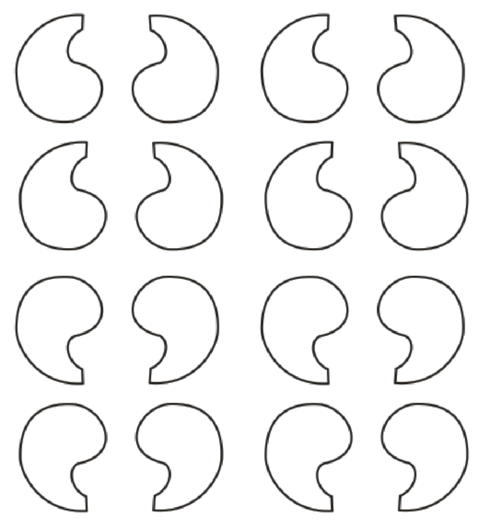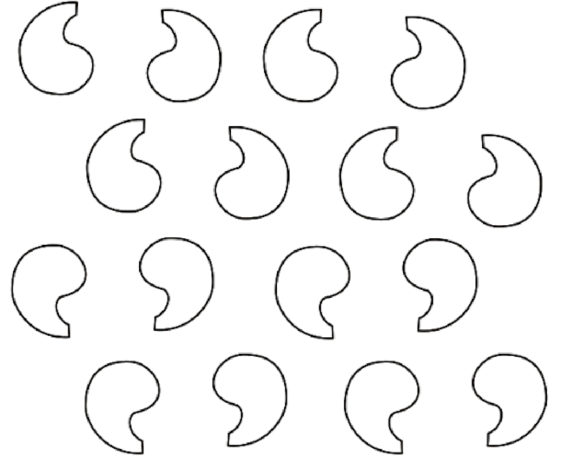
ACHIEVE/CHEMICAL PRINCIPLES ACCESS 1TERM
7th Edition
ISBN: 9781319399849
Author: ATKINS
Publisher: MAC HIGHER
expand_more
expand_more
format_list_bulleted
Concept explainers
Question
Chapter 3, Problem 3.37E
(a)
Interpretation Introduction
Interpretation:
Unit cell in two-dimensional lattice below has to be determined.

Concept Introduction:
Unit cell represents lattice structure if it stacked together repeatedly with no gaps and rotations. This can also produce whole crystals by stacking method. Basic type of unit cells is as follows:
1. Simple cubic (SC).
2. Body centered cubic (BCC).
3. Face centered cubic (FCC).
(a)
Interpretation Introduction
Interpretation:
Unit cell in two-dimensional lattice below has to be determined.

Concept Introduction:
Refer to part (a)
Expert Solution & Answer
Want to see the full answer?
Check out a sample textbook solution
Students have asked these similar questions
For the titration of a divalent metal ion (M2+) with EDTA, the stoichiometry of the reaction is typically:
1:1 (one mole of EDTA per mole of metal ion)
2:1 (two moles of EDTA per mole of metal ion)
1:2 (one mole of EDTA per two moles of metal ion)
None of the above
Please help me solve this reaction.
Indicate the products obtained by mixing 2,2-dimethylpropanal with acetaldehyde and sodium ethoxide in ethanol.
Chapter 3 Solutions
ACHIEVE/CHEMICAL PRINCIPLES ACCESS 1TERM
Ch. 3 - Prob. 3A.1ASTCh. 3 - Prob. 3A.1BSTCh. 3 - Prob. 3A.2ASTCh. 3 - Prob. 3A.2BSTCh. 3 - Prob. 3A.3ASTCh. 3 - Prob. 3A.3BSTCh. 3 - Prob. 3A.1ECh. 3 - Prob. 3A.2ECh. 3 - Prob. 3A.3ECh. 3 - Prob. 3A.4E
Ch. 3 - Prob. 3A.5ECh. 3 - Prob. 3A.6ECh. 3 - Prob. 3A.7ECh. 3 - Prob. 3A.8ECh. 3 - Prob. 3A.9ECh. 3 - Prob. 3A.10ECh. 3 - Prob. 3B.1ASTCh. 3 - Prob. 3B.1BSTCh. 3 - Prob. 3B.2ASTCh. 3 - Prob. 3B.2BSTCh. 3 - Prob. 3B.3ASTCh. 3 - Prob. 3B.3BSTCh. 3 - Prob. 3B.4ASTCh. 3 - Prob. 3B.4BSTCh. 3 - Prob. 3B.5ASTCh. 3 - Prob. 3B.5BSTCh. 3 - Prob. 3B.6ASTCh. 3 - Prob. 3B.6BSTCh. 3 - Prob. 3B.7ASTCh. 3 - Prob. 3B.7BSTCh. 3 - Prob. 3B.8ASTCh. 3 - Prob. 3B.8BSTCh. 3 - Prob. 3B.1ECh. 3 - Prob. 3B.2ECh. 3 - Prob. 3B.5ECh. 3 - Prob. 3B.6ECh. 3 - Prob. 3B.9ECh. 3 - Prob. 3B.10ECh. 3 - Prob. 3B.11ECh. 3 - Prob. 3B.12ECh. 3 - Prob. 3B.13ECh. 3 - Prob. 3B.14ECh. 3 - Prob. 3B.15ECh. 3 - Prob. 3B.16ECh. 3 - Prob. 3B.17ECh. 3 - Prob. 3B.18ECh. 3 - Prob. 3B.19ECh. 3 - Prob. 3B.20ECh. 3 - Prob. 3B.21ECh. 3 - Prob. 3B.22ECh. 3 - Prob. 3B.23ECh. 3 - Prob. 3B.24ECh. 3 - Prob. 3B.25ECh. 3 - Prob. 3B.26ECh. 3 - Prob. 3B.27ECh. 3 - Prob. 3B.28ECh. 3 - Prob. 3B.29ECh. 3 - Prob. 3B.30ECh. 3 - Prob. 3B.31ECh. 3 - Prob. 3B.32ECh. 3 - Prob. 3B.33ECh. 3 - Prob. 3B.34ECh. 3 - Prob. 3B.35ECh. 3 - Prob. 3B.36ECh. 3 - Prob. 3B.37ECh. 3 - Prob. 3B.38ECh. 3 - Prob. 3B.39ECh. 3 - Prob. 3B.40ECh. 3 - Prob. 3B.41ECh. 3 - Prob. 3B.42ECh. 3 - Prob. 3C.1ASTCh. 3 - Prob. 3C.1BSTCh. 3 - Prob. 3C.2ASTCh. 3 - Prob. 3C.2BSTCh. 3 - Prob. 3C.3ASTCh. 3 - Prob. 3C.3BSTCh. 3 - Prob. 3C.1ECh. 3 - Prob. 3C.2ECh. 3 - Prob. 3C.3ECh. 3 - Prob. 3C.4ECh. 3 - Prob. 3C.5ECh. 3 - Prob. 3C.6ECh. 3 - Prob. 3C.7ECh. 3 - Prob. 3C.8ECh. 3 - Prob. 3C.9ECh. 3 - Prob. 3C.10ECh. 3 - Prob. 3C.11ECh. 3 - Prob. 3C.12ECh. 3 - Prob. 3C.13ECh. 3 - Prob. 3C.14ECh. 3 - Prob. 3C.15ECh. 3 - Prob. 3C.16ECh. 3 - Prob. 3D.1ASTCh. 3 - Prob. 3D.1BSTCh. 3 - Prob. 3D.2ASTCh. 3 - Prob. 3D.2BSTCh. 3 - Prob. 3D.1ECh. 3 - Prob. 3D.2ECh. 3 - Prob. 3D.3ECh. 3 - Prob. 3D.4ECh. 3 - Prob. 3D.5ECh. 3 - Prob. 3D.6ECh. 3 - Prob. 3D.7ECh. 3 - Prob. 3D.8ECh. 3 - Prob. 3D.9ECh. 3 - Prob. 3D.10ECh. 3 - Prob. 3D.11ECh. 3 - Prob. 3D.12ECh. 3 - Prob. 3D.13ECh. 3 - Prob. 3D.14ECh. 3 - Prob. 3D.15ECh. 3 - Prob. 3D.16ECh. 3 - Prob. 3D.17ECh. 3 - Prob. 3D.18ECh. 3 - Prob. 3E.1ASTCh. 3 - Prob. 3E.1BSTCh. 3 - Prob. 3E.1ECh. 3 - Prob. 3E.2ECh. 3 - Prob. 3E.3ECh. 3 - Prob. 3E.4ECh. 3 - Prob. 3E.5ECh. 3 - Prob. 3E.6ECh. 3 - Prob. 3E.7ECh. 3 - Prob. 3E.8ECh. 3 - Prob. 3E.9ECh. 3 - Prob. 3E.10ECh. 3 - Prob. 3E.13ECh. 3 - Prob. 3E.14ECh. 3 - Prob. 3F.1ASTCh. 3 - Prob. 3F.1BSTCh. 3 - Prob. 3F.2ASTCh. 3 - Prob. 3F.2BSTCh. 3 - Prob. 3F.3ASTCh. 3 - Prob. 3F.3BSTCh. 3 - Prob. 3F.1ECh. 3 - Prob. 3F.2ECh. 3 - Prob. 3F.3ECh. 3 - Prob. 3F.4ECh. 3 - Prob. 3F.5ECh. 3 - Prob. 3F.6ECh. 3 - Prob. 3F.7ECh. 3 - Prob. 3F.8ECh. 3 - Prob. 3F.9ECh. 3 - Prob. 3F.10ECh. 3 - Prob. 3F.11ECh. 3 - Prob. 3F.12ECh. 3 - Prob. 3F.13ECh. 3 - Prob. 3F.14ECh. 3 - Prob. 3F.15ECh. 3 - Prob. 3F.16ECh. 3 - Prob. 3F.17ECh. 3 - Prob. 3F.18ECh. 3 - Prob. 3F.19ECh. 3 - Prob. 3F.20ECh. 3 - Prob. 3F.21ECh. 3 - Prob. 3F.22ECh. 3 - Prob. 3G.1ECh. 3 - Prob. 3G.2ECh. 3 - Prob. 3G.3ECh. 3 - Prob. 3G.4ECh. 3 - Prob. 3G.5ECh. 3 - Prob. 3G.6ECh. 3 - Prob. 3G.7ECh. 3 - Prob. 3G.8ECh. 3 - Prob. 3G.9ECh. 3 - Prob. 3G.10ECh. 3 - Prob. 3G.11ECh. 3 - Prob. 3G.12ECh. 3 - Prob. 3G.13ECh. 3 - Prob. 3G.14ECh. 3 - Prob. 3G.15ECh. 3 - Prob. 3G.16ECh. 3 - Prob. 3G.17ECh. 3 - Prob. 3G.18ECh. 3 - Prob. 3H.1ASTCh. 3 - Prob. 3H.1BSTCh. 3 - Prob. 3H.2ASTCh. 3 - Prob. 3H.2BSTCh. 3 - Prob. 3H.3ASTCh. 3 - Prob. 3H.3BSTCh. 3 - Prob. 3H.4ASTCh. 3 - Prob. 3H.4BSTCh. 3 - Prob. 3H.5ASTCh. 3 - Prob. 3H.5BSTCh. 3 - Prob. 3H.1ECh. 3 - Prob. 3H.2ECh. 3 - Prob. 3H.3ECh. 3 - Prob. 3H.4ECh. 3 - Prob. 3H.5ECh. 3 - Prob. 3H.6ECh. 3 - Prob. 3H.7ECh. 3 - Prob. 3H.8ECh. 3 - Prob. 3H.9ECh. 3 - Prob. 3H.10ECh. 3 - Prob. 3H.11ECh. 3 - Prob. 3H.12ECh. 3 - Prob. 3H.13ECh. 3 - Prob. 3H.14ECh. 3 - Prob. 3H.15ECh. 3 - Prob. 3H.16ECh. 3 - Prob. 3H.17ECh. 3 - Prob. 3H.19ECh. 3 - Prob. 3H.20ECh. 3 - Prob. 3H.23ECh. 3 - Prob. 3H.24ECh. 3 - Prob. 3H.25ECh. 3 - Prob. 3H.26ECh. 3 - Prob. 3H.27ECh. 3 - Prob. 3H.28ECh. 3 - Prob. 3H.29ECh. 3 - Prob. 3H.30ECh. 3 - Prob. 3H.31ECh. 3 - Prob. 3H.32ECh. 3 - Prob. 3H.33ECh. 3 - Prob. 3H.34ECh. 3 - Prob. 3H.35ECh. 3 - Prob. 3H.36ECh. 3 - Prob. 3I.1ASTCh. 3 - Prob. 3I.1BSTCh. 3 - Prob. 3I.2ASTCh. 3 - Prob. 3I.2BSTCh. 3 - Prob. 3I.3ASTCh. 3 - Prob. 3I.3BSTCh. 3 - Prob. 3I.4ASTCh. 3 - Prob. 3I.4BSTCh. 3 - Prob. 3I.1ECh. 3 - Prob. 3I.2ECh. 3 - Prob. 3I.3ECh. 3 - Prob. 3I.4ECh. 3 - Prob. 3I.5ECh. 3 - Prob. 3I.6ECh. 3 - Prob. 3I.7ECh. 3 - Prob. 3I.8ECh. 3 - Prob. 3I.11ECh. 3 - Prob. 3I.12ECh. 3 - Prob. 3I.13ECh. 3 - Prob. 3I.14ECh. 3 - Prob. 3I.15ECh. 3 - Prob. 3I.16ECh. 3 - Prob. 3J.1ASTCh. 3 - Prob. 3J.1BSTCh. 3 - Prob. 3J.2ASTCh. 3 - Prob. 3J.2BSTCh. 3 - Prob. 3J.3ASTCh. 3 - Prob. 3J.3BSTCh. 3 - Prob. 3J.1ECh. 3 - Prob. 3J.2ECh. 3 - Prob. 3J.3ECh. 3 - Prob. 3J.4ECh. 3 - Prob. 3J.5ECh. 3 - Prob. 3J.6ECh. 3 - Prob. 3J.7ECh. 3 - Prob. 3J.8ECh. 3 - Prob. 3J.9ECh. 3 - Prob. 3J.10ECh. 3 - Prob. 3J.11ECh. 3 - Prob. 3J.12ECh. 3 - Prob. 3J.13ECh. 3 - Prob. 3J.14ECh. 3 - Prob. 3J.15ECh. 3 - Prob. 3J.16ECh. 3 - Prob. 3.1ECh. 3 - Prob. 3.2ECh. 3 - Prob. 3.3ECh. 3 - Prob. 3.4ECh. 3 - Prob. 3.5ECh. 3 - Prob. 3.6ECh. 3 - Prob. 3.7ECh. 3 - Prob. 3.8ECh. 3 - Prob. 3.9ECh. 3 - Prob. 3.10ECh. 3 - Prob. 3.11ECh. 3 - Prob. 3.12ECh. 3 - Prob. 3.13ECh. 3 - Prob. 3.15ECh. 3 - Prob. 3.18ECh. 3 - Prob. 3.19ECh. 3 - Prob. 3.23ECh. 3 - Prob. 3.24ECh. 3 - Prob. 3.25ECh. 3 - Prob. 3.26ECh. 3 - Prob. 3.27ECh. 3 - Prob. 3.29ECh. 3 - Prob. 3.31ECh. 3 - Prob. 3.32ECh. 3 - Prob. 3.35ECh. 3 - Prob. 3.36ECh. 3 - Prob. 3.37ECh. 3 - Prob. 3.38ECh. 3 - Prob. 3.40ECh. 3 - Prob. 3.41ECh. 3 - Prob. 3.42ECh. 3 - Prob. 3.45ECh. 3 - Prob. 3.47ECh. 3 - Prob. 3.49ECh. 3 - Prob. 3.50ECh. 3 - Prob. 3.51ECh. 3 - Prob. 3.53ECh. 3 - Prob. 3.54ECh. 3 - Prob. 3.55ECh. 3 - Prob. 3.56ECh. 3 - Prob. 3.57ECh. 3 - Prob. 3.58ECh. 3 - Prob. 3.59ECh. 3 - Prob. 3.60ECh. 3 - Prob. 3.61ECh. 3 - Prob. 3.62ECh. 3 - Prob. 3.63ECh. 3 - Prob. 3.64ECh. 3 - Prob. 3.65ECh. 3 - Prob. 3.66ECh. 3 - Prob. 3.67ECh. 3 - Prob. 3.68E
Knowledge Booster
Learn more about
Need a deep-dive on the concept behind this application? Look no further. Learn more about this topic, chemistry and related others by exploring similar questions and additional content below.Similar questions
- Synthesize 2-Ethyl-3-methyloxirane from dimethyl(propyl)sulfonium iodide using the necessary organic or inorganic reagents. Draw the structures of the compounds.arrow_forwardSynthesize 2-Hydroxy-2-phenylacetonitrile from phenylmethanol using the necessary organic or inorganic reagents. Draw the structures of the compounds.arrow_forwardSynthesize N-Methylcyclohexylamine from cyclohexanol using the necessary organic or inorganic reagents. Draw the structures of the compounds.arrow_forward
- Synthesize N-Methylcyclohexylamine from cyclohexanol using the necessary organic or inorganic reagents. Draw the structures of the compounds.arrow_forwardIf possible, please provide the formula of the compound 3,3-dimethylbut-2-enal.arrow_forwardSynthesize 1,4-dibromobenzene from acetanilide (N-phenylacetamide) using the necessary organic or inorganic reagents. Draw the structures of the compounds.arrow_forward
- Indicate the products obtained by mixing (3-oxo-3-phenylpropyl)triphenylphosphonium bromide with sodium hydride.arrow_forwardWe mix N-ethyl-2-hexanamine with excess methyl iodide and followed by heating with aqueous Ag2O. Indicate the major products obtained.arrow_forwardIndicate the products obtained by mixing acetophenone with iodine and NaOH.arrow_forward
- Indicate the products obtained by mixing 2-Propanone and ethyllithium and performing a subsequent acid hydrolysis.arrow_forwardIndicate the products obtained if (E)-2-butenal and 3-oxo-butanenitrile are mixed with sodium ethoxide in ethanol.arrow_forwardQuestion 3 (4 points), Draw a full arrow-pushing mechanism for the following reaction Please draw all structures clearly. Note that this intramolecular cyclization is analogous to the mechanism for halohydrin formation. COH Br + HBr Brarrow_forward
arrow_back_ios
SEE MORE QUESTIONS
arrow_forward_ios
Recommended textbooks for you
 Chemistry: Principles and PracticeChemistryISBN:9780534420123Author:Daniel L. Reger, Scott R. Goode, David W. Ball, Edward MercerPublisher:Cengage Learning
Chemistry: Principles and PracticeChemistryISBN:9780534420123Author:Daniel L. Reger, Scott R. Goode, David W. Ball, Edward MercerPublisher:Cengage Learning Principles of Modern ChemistryChemistryISBN:9781305079113Author:David W. Oxtoby, H. Pat Gillis, Laurie J. ButlerPublisher:Cengage Learning
Principles of Modern ChemistryChemistryISBN:9781305079113Author:David W. Oxtoby, H. Pat Gillis, Laurie J. ButlerPublisher:Cengage Learning Chemistry & Chemical ReactivityChemistryISBN:9781337399074Author:John C. Kotz, Paul M. Treichel, John Townsend, David TreichelPublisher:Cengage Learning
Chemistry & Chemical ReactivityChemistryISBN:9781337399074Author:John C. Kotz, Paul M. Treichel, John Townsend, David TreichelPublisher:Cengage Learning Chemistry & Chemical ReactivityChemistryISBN:9781133949640Author:John C. Kotz, Paul M. Treichel, John Townsend, David TreichelPublisher:Cengage Learning
Chemistry & Chemical ReactivityChemistryISBN:9781133949640Author:John C. Kotz, Paul M. Treichel, John Townsend, David TreichelPublisher:Cengage Learning Physical ChemistryChemistryISBN:9781133958437Author:Ball, David W. (david Warren), BAER, TomasPublisher:Wadsworth Cengage Learning,
Physical ChemistryChemistryISBN:9781133958437Author:Ball, David W. (david Warren), BAER, TomasPublisher:Wadsworth Cengage Learning, Chemistry: Principles and ReactionsChemistryISBN:9781305079373Author:William L. Masterton, Cecile N. HurleyPublisher:Cengage Learning
Chemistry: Principles and ReactionsChemistryISBN:9781305079373Author:William L. Masterton, Cecile N. HurleyPublisher:Cengage Learning

Chemistry: Principles and Practice
Chemistry
ISBN:9780534420123
Author:Daniel L. Reger, Scott R. Goode, David W. Ball, Edward Mercer
Publisher:Cengage Learning

Principles of Modern Chemistry
Chemistry
ISBN:9781305079113
Author:David W. Oxtoby, H. Pat Gillis, Laurie J. Butler
Publisher:Cengage Learning

Chemistry & Chemical Reactivity
Chemistry
ISBN:9781337399074
Author:John C. Kotz, Paul M. Treichel, John Townsend, David Treichel
Publisher:Cengage Learning

Chemistry & Chemical Reactivity
Chemistry
ISBN:9781133949640
Author:John C. Kotz, Paul M. Treichel, John Townsend, David Treichel
Publisher:Cengage Learning

Physical Chemistry
Chemistry
ISBN:9781133958437
Author:Ball, David W. (david Warren), BAER, Tomas
Publisher:Wadsworth Cengage Learning,

Chemistry: Principles and Reactions
Chemistry
ISBN:9781305079373
Author:William L. Masterton, Cecile N. Hurley
Publisher:Cengage Learning
Unit Cell Chemistry Simple Cubic, Body Centered Cubic, Face Centered Cubic Crystal Lattice Structu; Author: The Organic Chemistry Tutor;https://www.youtube.com/watch?v=HCWwRh5CXYU;License: Standard YouTube License, CC-BY